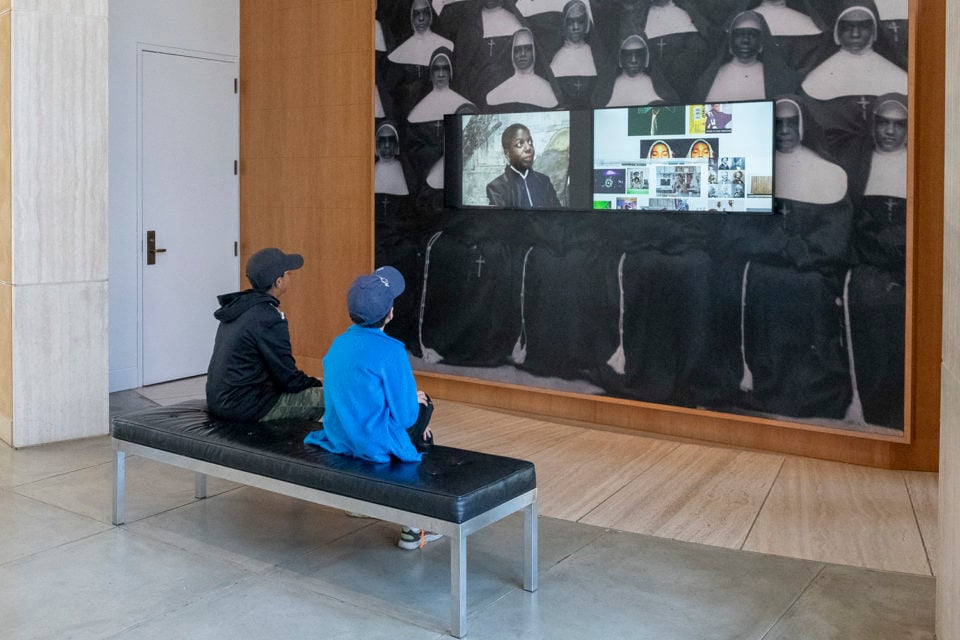When sitting down on a small black couch in the Cantor Arts Center, or in a chair at Harmony House or Lakeside Dining, the striking, wall-length, black-and-white photograph of nuns first catches the eye.
To avoid the nuns’ glare, one may look toward the two television screens placed in the center of the wall. The scenes on the screens may seem like a mess at first, both visually and auditorily — a kind of unconventional news show of sorts — but soon, the purpose becomes clear. This isn’t an ordinary news broadcast, but one dedicated entirely to one of the most underrepresented and misrepresented groups in America: black people.
Over the years, artist Kahlil Joseph has amassed fame for his striking short films, usually centered around black culture and excellence. He’s worked for superstars including Kendrick Lamar and Beyonce.
Joseph’s latest work, BLKNWS, is a makeshift news broadcast displayed on two television screens placed side by side, showcasing aspects of the black community that aren’t usually covered by major news channels. His exhibit has been on display since Oct. 2018 in the Cantor Arts Center, Harmony House and in the dining hall of Lagunita. The exhibit closes on Nov. 25.
Like much of Joseph’s work, BLKNWS is as symbolic as it is informative, combining news and visual art in order to present a thought-provoking concept: how news channels would look if they were not biased against the black community. Joseph manages to express this idea with the use of two simple television screens that can be found in the typical American home. By using two screens rather than one, Joseph is allowed more creative freedom in how he chooses to tell the stories of the black community, and is able to seamlessly incorporating artistic elements into his makeshift news broadcast.
Though it might seem like a mess at first glance, loud rap music drowning out the sound of an interview or seemingly unrelated images and videos being displayed side by side, every choice in Joseph’s art holds meaning. The distinctive characteristic behind his pieces is that much of their meaning is up to interpretation.
Throughout BLKNWS, Joseph includes videos that might appear completely unrelated to black culture and identity, like an interview of Jim Carrey at New York Fashion Week in 2017 or a CGI animation of a dinosaur trying to dodge meteors hurtling toward the earth. However, these videos all tie together to represent core ideas central to black culture. To some, the video of the dinosaur running from meteors might represent the extinction of black culture due to its lack of representation in the media, while others might have a different interpretation. Joseph’s work forces the viewer to immerse themselves in it in order to fully grasp the ideas and concepts he expresses, which are often presented in abstract ways.
Joseph relies heavily on music and video in most of his pieces. In m.A.A.d, a short film inspired by Lamar’s 2012 album Good Kid, m.A.A.d City that was displayed in the Museum of Contemporary Art in Los Angeles in 2015, Joseph overlapped music from Lamar’s album with clips of daily life in Compton, while also presenting his film on a double screen, like he does with BLKNWS. By combining Lamar’s music with footage of Compton, Joseph manages to create a striking piece that blurs the lines between a music video and a short film.
Joseph uses these same methods in BLKNWS, juxtaposing pop and rap music with various audio and video clips. For example he overlaps a video of a dinosaur screaming with an audio clip of someone talking about the extinction of black culture through the media. With audio and video, Joseph is not only able to educate his audiences, but also paint an image of black culture in their minds, bringing them along on a journey to either discover or revisit the true meaning of what it means to be black in America.
As with any news show, Joseph’s has news anchors, including influential figures like actress Amandla Stenberg, who deliver the news in unconventional and sometimes humorous ways.
However, not all topics Joseph covers in his piece are lighthearted. His goal is to show all aspects of the black community that aren’t equally represented by the media, and that includes violence and hate crimes against them. Violence against blacks in America is a huge part of black culture, dating back to when Africans were brought to the United States to work as slaves.
Joseph doesn’t choose to focus only on positive aspects of being black in America, but instead presents an overarching view, equally showcasing good and bad, something major news channels nowadays fail to do.
BLKNWS is a prime example of the result of combining journalism and art, fact and creativity. Though it can be a lot to take in, with images sometimes flying by quickly, Joseph’s work manages to stick with audiences for a long time. It can be hard to understand everything he’s trying to communicate at once, but this lets the viewer think, to wonder why he decided to put two clips side by side, what the significance of the clips is and why he chose one song rather than another.
Though Joseph has not confirmed plans, some have expressed hope that BLKNWS transforms from an art exhibit into an actual broadcast seen by viewers around the world. BLKNWS was originally created to tell the untold stories of the black community that most news channels choose to leave out. A broadcast would help fill the gap left by news and media companies regarding the equal representation of black culture and writers in the media. It could alter the ways we perceive seemingly news outlets, and could call further into question their reliability.
Contact Jasmine Venet at jasminevenet28 ‘at’ gmail.com.
